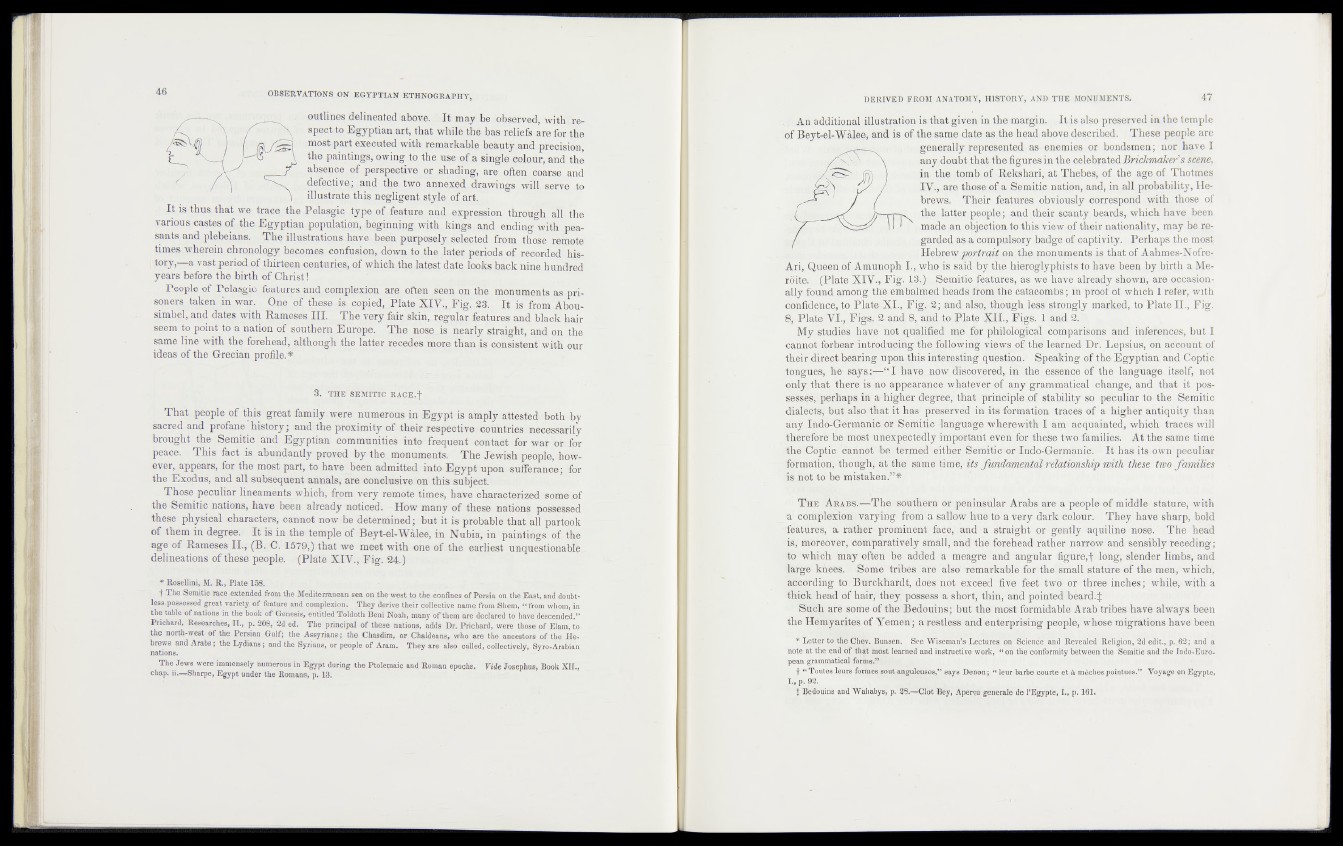
outlines delineated above.| I t may, .be bbsenvod, with'fte-
spect to Egyptian .act, that while the bas-reliefs are for the
most part executed with remarkable beautytand precision,
the paintings, owing to the use of a single .colour, and the
absence , of perspective, gg^hading, are oftem coarse and
defective.; and the t\y<£ annexed drawings will-serve to
illustrate this negligent style of art.
i t is thus that we trace the Pelasgic type of featjirq and expression through âÇ the
various castes of the Egyptian.population, beginning with kipgs and ending with peasants
and plebeians. The illustrations have been purposely, spirited from those remote
•times, wherein chronology l^gpjipp|,^nfusian, down to the later periods ,df recor'ded’-his-
\tory,—a vast period of thirteen penturi.es, of ^ b ich jb e latest date loqks hack nine h und-sed
years before the birth of Christ !
People of TelasjgjjC features, aadpopiplexion are often tsêep;-on- the monuments as pri-
soners taken in war, It' is ftom ^bousimbeh
and dates with Rameses III. T |e very fair skin, regular features and black hair
seem to point to a nation of southern Europe. The nose, is .ijparly straight, and oii^ltKc
same line with the forehead, although the latter recedes more than is consistent' with our-*
ideas of the Grecian profile.*
3. the sHM'inc RACE.t -
J That people of this great family were numerous in -Egypt is amply® attested ufedtlchy
lacred and profane history; and the proximity of their respective countries '.necessarily
brought the Semitic and Egyptian communities into frequent .contact fer w a r 'W a r
peace. T. s fact is abundantly proved by the monuments. »The Jewish people,^Jrofû-
pv^er, appears, for the most part, to havsTheen admitted into Egypt uponusafierance j *ier
the Exodus, and all subsequent annals, are cond®sive;cm:tWSiSHh|eGt.‘ 'r"
Those peculiar lineamentewhich, from very remote times, have characterized some-iof
-the îSéMitic nations, have been already noticed. How many of these national possessed
th ^ e physical characters, cannot now be determined ; but it is probable-thatiaIt.:pai;took'
o# them ih degree,- RTSs in the temple of Beytiél-Wàlee, in Nubia, kl 'paihlidtfs^èsîfe
age of R amie s Hiy (B, G. 1579,') «bat we meet with one of the earliest itrifquebtionabjjp..
delineations of these peopM ^Plâté X lf ,, Rig. 24.)
* Rosefliai^M. B., Elate 138.
f 3 $p Setnitipra^g ,exteBde4 from the M oditemflean sea on # ie w«st ^ lte ^ o ijf in e 3 ,o f Persia on tljéjEaist, and doilbt-
less possessed great variety o f feature and complexion They derive their collective name from Shem, "from whom, in
the table of nations ih the book of Genesis, fidtltled Toldoth: Beni Noah, many of them are declared to have descended.’’
Prichard, Researches, II., p. 208, 2d ed. The principal of these nations, adds Dr. Prichard were those of Elam, to .
the north-west of the Persian Gulf; the Assyrians; the Chasdim, or Chaldeans, who are tb$ anoestorS of. the. H e brews
and Arabs; the Lydians ; and the Syrians, or people of Aram. They are also' called, C oBëSlilf, Syre-Arabian
nations.
The Jews wereiùîiàënselÿfiiWereusi_teiEgypt during the Ptotejpaie and fcoinan epochs, Vide fosephus, Book X IÇ
chap, ii.—-Sharpe, Egypt under the Romans, p. 13.
. is that gifftpHls^e taargin, Itisa lso preserved in the temple
®f Beyt-el-,Walee, and is of, the,same date as the head above described, These people are
sg^nqigiJ^-reiprp^ejjted as enemies, or bondsmen; nor have I
i lanyidpipibj that the figures in the celebrated Brickmahef s scene,
iij. )th^(t°i|pkt0i R^kshari, at Thebes, of the age of Thotmes
p S iN ^ e in all prphahility> He-
I ^ ifp lr .^ tp r e s obviopslv correspond with those of
tha.Iatter^ a ffa ^ - .a^djtbeip scanty beards, which have .been
view of their nationality, may be re»
Perhaps the most
°C Aahmes-Nofre-
Arij A munoph J it^^p^^|lSKtrip^Kjfe&]iv;pHi^ls«6fmve been, hy birth a Meroite.
f|®a^e XIY., Tfnw =*• a>ry e m^f e lready. shown, are occasmnqlly&
upd among tile embalmed heads>ffio.m the catacombs; 'in ‘prp.ofof Which I refer, with
rieb ^i(Umc^W,Pla^j\I, Fm ■ ^•mid;aM^mmuirb les§~strongly marked, to R la te ^ p Fig.
flsPlate r a H Ei-hsi 'Tigs. l\and .2j||k
My stnd.iost.,'laWe \rafe E r 'p^lolp^cal coihparijopj-iaM? inferences, .but I
cannot’ferbear-’intrqd^pg^e^y.I^^W-^jtfleivs q|fthR learned Dr. ^epsius, on aobount of
tbeii*(w^t'rb1oar.iiig^OT^Ais i«CTasMfr. mSsiaonO,.Spehkih’gxp^the Egyptian and Coptic
essence ©frthe -language itself, not
only,that There giauM’iMcpkf change, and, tbqti |t possessed*
' pbeM-aps iff aJJh f g ] | § > s K i b i l i t y ) S o b p l d h l i a r to tlie Semitic
diLa'le&fs’,: blit* alsddfehat it has!'pi oKer-'frd tiiiws,formation, -tr a fe es of'a^higher antiquity than
an ƒ STO^mknanie.ip^Sefettw^^^^gage^M^KwifMnam which traces will
TOosk •unexpectedly (fnipoitaht fetaiffifslo J^Lt the sitae time
.^^d>^®c^Ii'Hi|tl*be"iAcVinc(i» It* 1 i^its-ownlpfeculiar
^ormS'tiori®: thotfgh; 'at the s§m^iM%f4ts‘^Ji<M0erit(Mf^e&fbksh^mith-‘Wiese' tw'o families
ts ttiabemfsthkonf 1%
n> ®sfi southern) ©ai1 MSntfMula^iArabstMpe^^inlgfefaitif middle stature, with
%i cor§pléMo%iviLfying'ftfemla s ^ d ^ ^ ^ X o ^ ^^dn'fecdloufe#sWiiêj^fiave'sharp, bold
sfeatfirëS, ' à ntmi»tivibnîltigraOTÿ-^a^il^mKfùsdit-'(,Ttiè fke^i
fi4î'™ ^® ^ r^ ‘êfmtp’airabrv‘d f sffialfwaM^th'e fo^eh^a(.lî^lR^wiMiÎA®^tfi/f^i0My«Tecediiigi;
àb'^whioh iÈS?ÿibfte*ù'sbweddfeti^,®itîeagréï'ai&tM ^ ^ f slender limbs,.anti
fâkgb- fch^hÙ's^&n^e'lMhl'S «'are also-■remat'kalb'lê fottihe&nallstjïifed%fbühe men, which;
^W rd ih g tb'-BT^BSSRR, c®|^m?teV(,èt^Dfi\'ë fecf*'fv^ôrrXtiieccïni<®§b; whiîéjfwith a
thick hYâtitSf hait^tÉfey.ipog’së'sS^a^h’èî't/thin, ^si^edihèard.^:'.
| arfe 'sothe oftho'HRedoumS^bÿtnthè'most' foiMifdable Arab tribes«haifé always been,
•the Bemyarites of-Yemen; a%^tless,and'.enterpfisihg-:pe'®plé,iwhpsemigrations have .been
i* L e tr e ^ ^W ® ^ « B u n s e n . LoLtuii/^i ^ ^ i i 'n c i ï a ^ ^ ^ ^ W ^ R t l i g i p ^ Æ e/iit., p/^62; and a
note at the end of that most learned and instraetive work, ‘‘ on the conformity between the Semitic and the Inào-Euro-
ipean grammatical?forms.^ü i ; i
f “ Toutes leurs fondes, sont, anguleuses,’’ says Den on ; “ leur barbe courte et à mèches pointu es.” Voyage en Egypte,
IwJ). 92.
f Bédouins and Wahabys, p. â o ^ t î ib t Bey, Âpeççu generale de l’Egypte, L, p. 161,